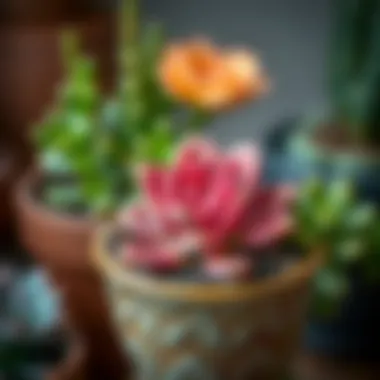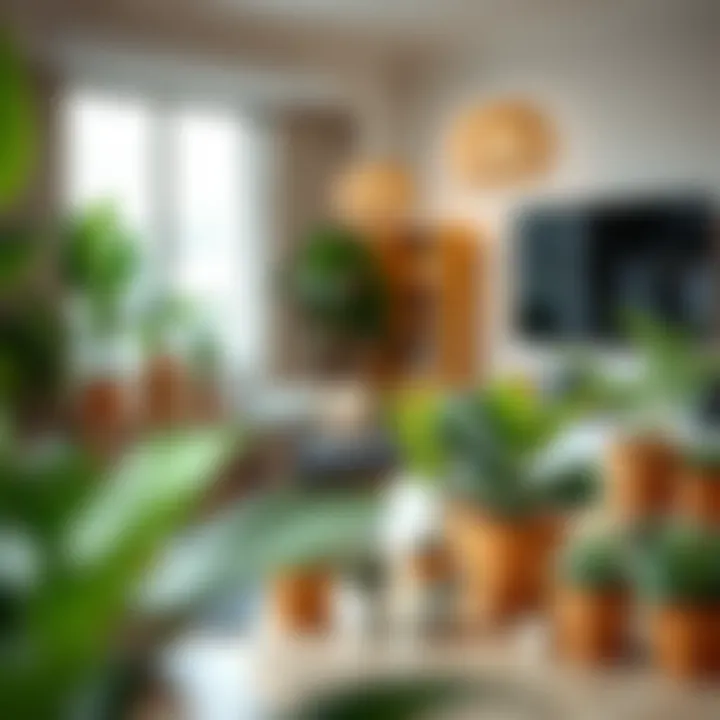Exploring the Benefits of Small Home Plants


Intro
Small home plants have taken the interior decor world by storm, transforming spaces into vibrant, breathing havens. They're not just mere decorations; they embody a sense of life and vigor that is often lacking in contemporary living environments. When it comes to decorating our homes, these plants serve as a unique blend of art and nature, pairing functionality with aesthetics. From the sprawling leaves of a Monstera to the petite charm of a succulent, each plant tells a story, enhancing our connection to the environment while improving our overall well-being. In today's fast-paced lives, introducing greenery into our homes can significantly impact our mood and mental health, creating a soothing ambiance amid the chaos.
Now, let’s delve deeper into why these small plants matter and how they can weave into the fabric of our daily lives.
The Aesthetic Appeal of Small Home Plants
Enhancing the visual appeal of living spaces is one of the most straightforward benefits of incorporating small home plants. These plants come in various shapes, sizes, and colors that can complement or contrast different design styles.
Imagine entering a minimalist living room; adding a splash of vibrant green with a small snake plant or a colorful pot of African violets can draw the eye and break the monotonous palette. Often, plants can make a room feel more cohesive while adding layers of texture and warmth.
Creating a Cohesive Look
When incorporating plants into your decor, consider the following:
- Choose pots that align with your design theme: Whether it’s rustic, modern, or eclectic, selecting pots that reflect your style enhances the overall aesthetic.
- Mix and match sizes: Varying heights draws attention and creates visual interest. Place taller plants beside lower ones for a balanced look.
- Group plants in odd numbers: Arranging plants in groups of three or five tends to be more appealing than even-numbered arrangements, following the principles of asymmetry in design.
Health Benefits of Indoor Greenery
Numerous studies sing the praises of indoor plants as natural air purifiers. Plants like the peace lily and Boston fern can help filter toxins from the air, significantly improving indoor air quality. Furthermore, connecting with greenery has shown to reduce stress and anxiety levels, promoting a sense of calm within the home.
Enhancing Wellbeing
Here are some tangible ways plants contribute to our health:
- They can increase productivity and concentration.
- Maintaining a green space encourages mindfulness and care, keeping you anchored.
- Plants have unique abilities to heighten creativity and boost mood.
"Indoor plants are not just for show; they’re a breath of fresh air in our homes and lives."
Varieties Suited for Indoor Environments
When it comes to selecting the right small plants for your home, it's essential to consider factors like light levels and humidity. Here are a few champions of indoor plant life:
- Spider plant: Hardy and adaptable, perfect for beginners.
- Snake plant: Thrives on neglect, perfect for busy lifestyles.
- Pothos: Known for its trailing vines, adds elegance to any corner.
- ZZ plant: An ideal choice for dim corners, it’s a survivor in low-light conditions.
Small home plants not only sprout life into any room but can also adapt to various conditions, making them suitable companions for modern living.
Essential Care Tips
Taking care of your small plants doesn’t have to be a chore. Here are some practical care tips:
- Light: Understand the light requirements of each plant – whether they need bright, indirect light or can tolerate shadows.
- Watering: Adopt the “less is more” philosophy; overwatering is a common pitfall for many plant parents.
- Humidity: Some plants thrive in higher humidity; consider misting or placing them in more humid areas like the bathroom.
Integrating Natural Elements into Contemporary Living Spaces
In a world increasingly driven by technology and artificial decor, integrating small plants into the home can rekindle our relationship with nature. From corner shelves to window sills, there's no limit to where they can thrive. Make them a focal point or utilize them as subtle accents throughout the space.
Sustainable Practices in Plant Care
Being mindful of our environmental footprint is paramount in today’s society. Opting for plants that require less water and care aids sustainability efforts. Moreover, consider propagating your plants as a means of sharing greenery with others while keeping costs down.
By leveraging small home plants effectively, homeowners not only amplify the aesthetic potential of their space but also contribute positively to their mental health and well-being. With the right knowledge and nurturing, you can transform any environment into a leafy sanctuary, enhancing both decor and life within.
Prologue to Small Home Plants
When we think about our homes, the ambiance often relies on the smallest nuances. Small home plants play a significant role in creating this atmosphere. They bring a breath of life, transforming dull spaces into lively sanctuaries. Homeowners and decorators alike increasingly recognize that these petite green companions are not just decor accessories but rather essential elements that influence our environment positively.
Defining Small Home Plants
What exactly are small home plants? In simple terms, these are plants that can thrive in limited spaces, often requiring minimal care. They typically fit well on mantels, shelves, desks, or even windowsills. Think about the lovely Pothos, with its cascading vines, or the trusty Spider Plant that hardly knows what a bad day is. These plants often stand less than three feet tall and come in various shapes and colors, making them versatile additions to any interior.
Moreover, the definition spans a range of species including succulents, herbs, and even small flowering varieties. They are particularly appealing to indoor gardeners and those with busy lifestyles, as many of them require less attention compared to larger plants.
Historical Context of Indoor Gardening
Indoor gardening is not a modern concept. In fact, it has roots deeply embedded in ancient civilizations. Historical records indicate that the Egyptians cultivated plants indoors, using them for practical purposes like medicine and cosmetics. Fast forward to the 16th century, when the Dutch took the art of maintaining indoor gardens to new heights. They began using glass containers, known as cloches, to create microhabitats for delicate plants.
As time marched on, various cultures adopted their own forms of indoor plantkeeping, from the chewing on herbs for sustenance to decorating homes with small potted plants that mirrored the vibrant outdoor gardens. The 20th century saw a resurgence, particularly during the era of urbanization, where city dwellers turned their compact apartments into green havens by introducing small plants.
Consequently, what began as mere survival and necessity evolved into a nuanced practice that combines aesthetics, practical use, and the quest for better air quality. Nowadays, homeowners recognize that indoor plants improve air conditions and enhance mental well-being, marrying beauty with function effortlessly.
In this intricate tapestry of history, small home plants have woven themselves into the very fabric of how we view and interact with our living spaces. They symbolize not just nature but our innate desire to connect with it, regardless of how busy the world outside becomes.
The Aesthetic Value of Small Plants
Small plants have a unique knack for transforming a space, adding not only visual richness but also creating a sense of harmony within the home. Their aesthetic value extends beyond simple decoration; it influences the mood and atmosphere of a room, making them essential for homeowners, interior designers, and decorators. Incorporating these plants can enhance home design by bringing in elements of nature, which often evokes feelings of tranquility and comfort.


Enhancing Home Design
When it comes to home design, small plants serve as versatile accessories that can revitalize both classic and contemporary spaces. By strategically placing these plants, one can create focal points that draw the eye while maintaining a cohesive look throughout. For instance, a small succulent in a modern kitchen or a charming potted herb on a sunny windowsill can breathe life into an otherwise sterile environment.
Moreover, the colors and textures found in plant life introduce a dynamic contrast to other materials and furnishings in the home. Deep greens can soften the sharp lines of furniture, while vibrant flowers provide unexpected pops of color. Such combinations can turn mundane areas into engaging visuals, creating balance and interest in various design styles.
Consider arranging small plants on bookshelves or alongside artwork; this mix can offer visual breaks, making the space more approachable and less formal. Additionally, plants can be arranged in groups, varying pot sizes and shapes, to create visual narratives that spark curiosity.
Creating Visual Interest
The role of small plants in creating visual interest cannot be overstated. These little green wonders can transform barren corners into sensory experiences that enliven the surroundings. For example, consider a room with a stark, minimalistic design; adding a small cluster of air plants suspended in a geometric holder can introduce a sense of whimsy.
Texture and shape play crucial roles here. Plants with varied leaf shapes, such as the spiky appearance of a cactus contrasted with the broad leaves of a pothos, create depth that catches the eye.
Further, through unique display methods like hanging planters or wall-mounted shelves, small plants can be used to craft lush vertical gardens. This approach not only conserves space but also invites attention from different angles, enhancing the overall ambiance.
"Plants are to homes what art is to galleries; they evoke emotions and spark conversations."
In summary, small plants represent an essential element in enhancing aesthetics at home. They marry functionality with design sensibility, allowing for a personal expression that resonates with every homeowner. Whether you are simply improving your space or designing it from scratch, incorporating small plants is a choice that brings both beauty and depth.
Physiological Benefits of Small Plants
Small home plants do wonders beyond just looking good on a windowsill. They offer a variety of physiological benefits that directly impact our environment and well-being. This section delves into how small plants enhance air quality and contribute to mental health, two significant areas where their presence can make a real difference.
Air Quality Improvement
Small plants do more than just beautify a space; they play a vital role in improving air quality. Many common houseplants—such as snake plants, peace lilies, and the beloved spider plant—are known for their air-purifying abilities. These plants filter out harmful pollutants, including formaldehyde, benzene, and carbon monoxide, reducing the concentration of indoor toxins.
- Natural filtration: Plants absorb pollutants through their leaves and roots, and in turn, release oxygen. This process not only leads to fresher air but can also help with respiratory issues. A simple addition of a few plants can result in noticeable improvements in overall air quality.
- Humidity regulation: Plants also contribute to humidity levels, releasing moisture through transpiration. This can be particularly beneficial in dry climates or during the winter months when indoor air often becomes parched. Higher humidity levels can prevent dry skin, respiratory problems, and even static electricity.
"The presence of even a few plants can significantly uplift the air quality in indoor spaces, thus promoting better health for inhabitants."
Engaging with small plants not only enhances aesthetics but also makes for a healthier living space in a practical way, allowing homeowners to breathe easier.
Stress Reduction and Mental Health
Integrating small plants into home environments can have profound effects on mental health and stress levels. Numerous studies suggest that simply being around greenery can elevate mood and promote a sense of calm. Consider these key points:
- Connection with nature: For many, the hustle and bustle of modern life can create a disconnect from nature. Small plants serve as a bridge, reminding us of the natural world. Indoors, they provide a hint of the outdoors, fostering a sense of peace.
- Therapeutic effects: Tending to plants may provide a therapeutic outlet, allowing individuals to engage in mindful activities that help reduce anxiety. The simple act of watering or pruning can act as a meditative practice, encouraging presence and focus.
- Increased Productivity: Research also highlights that individuals who have plants in their workspace report increased productivity and overall job satisfaction. The presence of greenery can stimulate creativity and promote a more positive atmosphere.
People often overlook the psychological impacts that small plants can have, but even a modest collection on a shelf can create a nurturing environment. The act of caring for plants may lead to reduced feelings of isolation and enhanced emotional well-being.
In summary, small plants are more than mere decor—they are vital contributors to improving air quality and fostering mental health. By integrating them into our living spaces, we can cultivate a happier, healthier life.
Popular Small Plants for Indoor Spaces
Choosing the right small plants for indoor spaces can transform not only the aesthetic quality of a room, but also enhance the overall atmosphere. Small home plants act as natural air purifiers, bringing life into otherwise dreary corners while having specific benefits based on their kinds. Familiarizing oneself with popular options is essential for home decorators and plant enthusiasts alike, as each plant comes with its unique charm and care requirements.
Succulents and Cacti
Succulents and cacti are often the go-to plants for many first-time green thumbs. These hardy varieties thrive on neglect, requiring little water and maintenance. Their unique thick leaves and spiny surfaces create an enchanting vibe.
- Benefits: Their resilience makes them perfect for busy individuals. Additionally, many succulents can be propagated easily, offering a fun project for plant lovers.
- Considerations: While they can manage in various lighting conditions, direct sunlight is ideal for some species. Placing them on a sunny windowsill can do wonders.
"Succulents are truly a testament to nature’s ability to adapt and survive in the harshest conditions."
Herbs for Home Use
Growing herbs at home is a delightful blend of functionality and aesthetics. Basil, mint, and rosemary are popular choices, bringing delightful aromas and tastes to the kitchen. There's something satisfying about plucking fresh basil leaves while cooking, grounding home cooks in their efforts.
- Benefits: Beyond improving your culinary creations, herbs can boost your mental well-being by engaging senses. Plus, they can attract pollinators when placed outside or on balconies.
- Considerations: Herbs typically require a bit more attention in terms of watering and light compared to succulents. They generally thrive in bright light and should be monitored for any signs of pests.
Air Plants
Air plants, or Tillandsia, are a fascinating group that can grow without soil. Their unique ability to absorb moisture through their leaves makes them ideal for creative displays. Often seen tucked in driftwood or terrariums, they’re a fantastic choice for a modern touch.
- Benefits: Their low maintenance needs and adaptability are perfect for those who want greenery without the fuss. A quick soak once a week is usually enough for these beauties.
- Considerations: Light requirements can vary between types, but most air plants prefer bright, indirect sunlight to avoid scorching.
Spider Plants and Pothos
Spider plants and pothos are champions when it comes to ease of care. The spider plant, known for its arching green leaves and baby plantlets, adds a lively touch. Meanwhile, pothos, with its trailing vines, makes a striking floor or hanging plant.
- Benefits: Both are excellent air purifiers, filtering out common household toxins. They also thrive in a variety of lighting conditions, making them versatile options.
- Considerations: While they can handle low light, keeping them in brighter areas encourages growth. Regular pruning not only tidies them up but promotes fuller foliage.
By understanding these popular small plants and their specific needs, homeowners and interior decorators can create inviting spaces that are not only visually appealing but also contribute to overall health and well-being.
Essential Care Tips for Small Plants


Caring for small home plants is not merely a hobby—it's a commitment to nurturing life within our living spaces. Selecting the right plant is just the starting point; understanding how to properly care for them is what transforms an ordinary home into a verdant oasis. In this section, we will explore essential care techniques that ensure your small plants not only survive but flourish, enhancing both your décor and well-being.
Watering Techniques
Watering is often the most discussed element of plant care, yet many people still struggle to find the right balance. Different plants have differing water needs; for instance, a succulent needs much less water than a fern.
- Check Soil Moisture: Before watering, always check the soil. A simple finger test can be effective. Stick your finger about an inch into the soil; if it feels dry, it's time for watering.
- Consistency Matters: Develop a schedule that aligns with your plants’ growth cycle. More water is necessary during growing seasons, while dormancy requires less.
- Water Distribution: It's vital to water evenly—failure to do so can lead to over or under-watering in certain areas. Use a watering can with a narrow spout for precision.
"Water is the essence of life for plants, but too much can drown them. Balance is key."
Light Requirements
Light is another fundamental aspect of plant care that can affect growth patterns and overall health. Assessing the amount of natural light in your home can guide your plant selection and placement.
- Know Your Plant: Different plants have unique light requirements. For example, pothos thrive in low light, while cacti prefer direct sunlight. Understand these needs before purchasing.
- Placement is Crucial: Finding the right spot in your home where light is optimal can make all the difference. Observe how sunlight moves through your space during the day to identify the best locations.
- Supplement with Artificial Lights: If natural light is scant, consider grow lights. Modern options come in many forms and are relatively easy to install, ensuring your plants get enough exposure.
Soil and Nutrient Needs
Quality soil is the backbone of healthy plants. It does more than hold roots; it provides necessary nutrients and drainage.
- Select the Right Soil Mix: Not all soil is created equal. Potting mixes are tailored for specific needs—cacti, for instance, thrive in gritty, well-draining mixes, while tropical plants prefer moisture-retaining soils.
- Nutrient Considerations: Regular fertilization is important during the growing season. A balanced fertilizer can be diluted in water and applied every few weeks, but be cautious—too much fertilizer can harm plants.
- Repotting Needs: As your plant grows, it may outgrow its pot. Repotting can rejuvenate the plant by giving it fresh nutrients and more space to grow.
By honing in on these essential aspects of plant care, you create a sustainable environment that nurtures growth. This attention to detail not only brings vibrancy to your home but also cultivates a rewarding connection to your indoor greenery.
Creating a Suitable Environment for Small Plants
Creating the right environment for small home plants is essential for their health and vitality. Plants, much like people, thrive in conditions that meet their specific needs. By understanding the fundamental elements that contribute to a flourishing indoor garden, homeowners can cultivate not just greenery but an overall sense of well-being within their living spaces.
Optimal Placement in the Home
The placement of small plants in a home can either make or break their growth. It’s not just about sticking them on a window sill and calling it a day; careful thought should be given to each plant's individual preferences. For instance, succulents typically enjoy a sunny spot where they can soak up the light, whereas ferns might prefer a more shaded, humid environment away from direct sunlight.
When deciding where to position your plants, consider the following:
- Natural Light: Assess how much natural light each area of your home receives throughout the day. South-facing windows are wonderful for light-loving plants, whereas north-facing windows are better suited for those that require less light.
- Mobility: Keep in mind that plants may need to be moved as seasons change or as light conditions shift. A plant that flourishes in a sunny spot in the summer might struggle come winter.
- Safety and Access: Place plants in areas that are not only protected from wandering pets or small children but also accessible for watering and maintenance.
Thoughtful placement can enhance both the aesthetic beauty of your space and the well-being of your plants. A little extra care in this area goes a long way.
Humidity and Temperature Considerations
Humidity and temperature play pivotal roles in plant health. Most indoor plants flourish in a relatively humid environment, typically between 40% and 60%. Yet many homes can be drier than a desert in the winter! This is due to heating systems that pull moisture from the air.
To ensure your plants feel comfortable:
- Humidity Levels: If you notice your plants developing crispy edges or brown spots, this could indicate inadequate humidity. Consider using a pebble tray filled with water under the pots or acquiring a small humidifier to boost moisture levels around your plants.
- Temperature Stability: Many plants prefer a stable temperature range between 65°F and 75°F. Sudden temperature fluctuations can lead to stress. Make sure to avoid placing plants close to drafty windows or heating vents, as these can create harsh conditions.
"A plant’s environment can profoundly affect its life cycle, just as the environment affects us. Understanding these subtleties will foster a thriving indoor ecosystem."
Ultimately, investing time to ensure your indoor environment is conducive to plant health pays off with vibrant, happy greenery that adds life to your space.
In summary, creating a suitable environment for small home plants involves both strategic placement and attentive care in terms of humidity and temperature. By being mindful of these elements, you underscore the importance of nurturing not only the plants but the ambiance of your home.
Integrating Small Plants into Home Decor
In the context of modern living, integrating small plants into home decor holds significant merit. These living elements not only beautify a space but also elevate its atmosphere, creating a harmonious blend of style and natural serenity. When homeowners start to weave plants into their decor, they can change the feel of a room drastically—from cold and lifeless to warm and inviting. With a little thought, small plants can act as the perfect companions to furniture and design choices, enriching the aesthetic while providing various health benefits.
Design Themes Complemented by Plants
Small plants have a unique ability to enhance a wide range of design themes, making them essential for creating cohesive interior spaces. For instance, in a minimalist design, where less is more, a single, elegant succulent can draw the eye without overwhelming the simplicity of the setting. Similarly, in a bohemian-style room, lush ferns and cascading pothos can introduce a vibrant burst of greenery, tying together various textures and colors of textiles used throughout the space.
The contrast they provide also plays a crucial role. In contemporary designs featuring sleek metal and glass, a small palm or rubber plant can introduce warmth and an organic element, softening the sharpness of the materials. Meanwhile, in rustic or farmhouse designs, herbs or small flowering plants in terracotta pots can accentuate the earthy tones, contributing to an overall sense of homeliness. Plants have the power to serve as focal points or subtle accents, making them versatile additions to any decor style.
Innovative Display Options
When it comes to displaying small plants, creativity knows no bounds. Homeowners can step away from the traditional pot-on-a-windowsill approach and explore innovative display options that bring character to their spaces.
- Hanging planters: Utilize vertical space to draw the eye upward. Consider macramé hangers or wall-mounted planters that not only save space but create a striking visual statement.
- Tiered plant stands: These can serve as miniature gardens. Stack them near windows to capture sunlight effectively while showcasing a variety of plant species in one spot.
- Terrariums: Enclosed glass containers allow for a miniature ecosystem. They are great conversation starters and can fit in nooks and crannies of your home, adding a touch of elegance.
- Shelving displays: Incorporating small plants among books, art pieces, or other decorative elements on shelves creates a layered appearance, enriching the display with both greenery and personality.
Sustainability in Plant Care
In today's world, where the effects of climate change are becoming increasingly evident, the importance of sustainability in all aspects of life cannot be overstated. This holds true for small home plants as well. Incorporating sustainability into plant care not only benefits the plants themselves but also extends to the environment, ensuring that resources are used wisely and responsibly. Small plants can thrive without depleting our natural resources if cared for judiciously. The responsibility of nurturing these living beings translates into a broader commitment to ecological balance and awareness.
Choosing Sustainable Varieties
Selecting plants that are naturally suited to the local environment is a key step in practicing sustainable plant care. Native plants are often hardier, require less water, and are better adapted to local pests and diseases. Some popular choices for indoor settings include:
- Snake plants: These are not only aesthetically pleasing but also purify the air and thrive on neglect.
- Pothos: Known for its trailing vines, it's both attractive and drought-resistant.
- Spider plants: Renowned for their air-cleaning abilities and resilience.


Moreover, consider sourcing plants from local nurseries rather than large commercial chains, which often rely on practices that are less sustainable. By purchasing locally, you support small businesses and contribute to a reduced carbon footprint.
Water-Saving Techniques
Water is a precious resource, and using it wisely is essential, especially in plant care. Adopting water-saving techniques helps maintain healthy plants without wasting this vital resource. Here are a few methods:
- Drip irrigation: This system targets the plant roots directly and minimizes evaporation.
- Collecting rainwater: Setting up barrels to collect rainwater is an eco-friendly method that provides plants a natural source of hydration.
- Self-watering pots: These can help regulate moisture and ensure plants receive consistent hydration without constantly needing attention.
"In an era marked by environmental consciousness, every drop counts. Implementing conservation techniques in plant care reflects a commitment to our planet's health."
In summary, embracing sustainability within plant care lays the groundwork for a healthier living space and a stronger connection to the environment. Choosing the right varieties and employing efficient watering techniques ensures that small home plants not only thrive but do so in harmony with the planet.
The Psychological Impact of Indoor Plants
The inclusion of small home plants in our living spaces goes far beyond mere aesthetic appeal. It taps into deeper psychological effects that can enhance our daily lives. Research shows that being surrounded by greenery can positively influence mental health, contribute to a sense of well-being, and foster a connection to nature that might otherwise be hard to find in urban environments. It’s no longer just a home decor choice but a holistic strategy to bolster overall happiness and comfort in one’s living space.
Connection to Nature
In the hustle and bustle of modern life, often we find ourselves entrenched in concrete jungles, where the sight of a tree or a flower is a rarity rather than a norm. This disconnection from nature is where small home plants provide invaluable benefits. Having plants indoors creates a sense of natural presence, effectively bridging the gap between the outdoors and the confines of our homes. Studies suggest that even just interacting with plants—whether it's watering them or pruning leaves—can evoke feelings of calm and tranquility.
Plants like English Ivy or the resilient Snake Plant not only purify the air but can also foster an emotional connection to the natural world. They remind us of life cycles—growth, decay, and rebirth—all of which resonate on a fundamental human level. When we engage with these living entities, we’re not just beautifying our spaces. We invite nature’s grounding qualities into our daily routines.
"Bringing nature indoors isn’t just good for our physical space; it’s a step towards nurturing our inner selves.”
Influence on Productivity and Creativity
The psychological effect of plants on productivity and creativity is hard to overlook. Workspaces adorned with greenery have been shown to boost focus and enhance cognitive functions. When you think about it, a simple desk plant might be the difference between a cluttered mind and a clear, successful day.
Research reveals an interesting correlation: individuals working in environments enriched with plants report increased levels of creativity and cognitive flexibility. Something as simple as a vibrant fiddle leaf fig or a few pots of herbs on your kitchen windowsill can sharpen your mind and elevate the ambience.
Here are a few specific benefits:
- Enhanced Focus: Contact with nature can help to reduce mental fatigue, making it easier to concentrate on tasks at hand.
- Creative Boost: Elements of nature stimulate different areas of our brains, often triggering new and innovative ideas.
- Mood Elevation: The presence of greenery has been linked to increased feelings of happiness and contentment, reducing anxiety in work or stress-heavy environments.
Incorporating small plants into both personal and professional settings is more than an aesthetic choice; it’s an investment in productivity and well-being.
Addressing Common Challenges in Plant Care
Taking care of small home plants can feel like navigating through a maze, especially for those unaccustomed to the unique demands of greenery that wants to take root in the living room or bedroom. This section aims to shed light on common challenges folks encounter and how to overcome them gracefully. Understanding these issues isn't just about keeping plants alive; it's about appreciating the journey of cultivating life in our spaces, reflecting our commitment to nurturing both beauty and well-being.
Pest Management Strategies
Pests can sneak up on you faster than you can say "green thumb." A healthy indoor plant can suddenly look like it’s taken a beating from the critters that find it a delightful buffet. Common pests include aphids, spider mites, and mealybugs. Tackling these uninvited guests starts with vigilance. Regular inspections can help catch the little buggers early. If you find them, don’t panic. Here’s a short guide to dealing with them:
- Neem Oil: This natural remedy can deter pests without harming your plants or the environment.
- Soap and Water Solution: A simple mixture can be effective against many insects. Just soap, water, and a little elbow grease.
- Introduce Beneficial Insects: Ladybugs, while cuties, can munch on aphids, naturally reducing their numbers.
- Keep it Clean: Plant debris and dust create perfect hiding spots; maintaining cleanliness can discourage infestations.
By taking these steps, you're not just saving your plants but also enhancing your living environment, creating a tranquil space free from pests.
Dealing with Plant Diseases
Plant diseases are another hurdle that can throw a wrench in your plans. From root rot to fungal infections, many issues can plague our little green friends. The key here is prevention, but if illness strikes, knowing how to deal with it can save your plants from doom.
Here are common ailments and their antidotes:
- Root Rot: Often due to overwatering. Use well-draining soil and pots with drainage holes. If plants seem mushy at the base, it might be time for a repot.
- Leaf Spot: Usually a sign of overwatering or poor air circulation. Prune affected leaves and allow plants to dry out adequately.
- Powdery Mildew: A surface fungus that manifests as an unsightly white coating. Increase air flow around your plants and consider removing heavily infested leaves.
As with pest control, the earlier you address these problems, the better chance you have to save your plant. Keeping a close eye on your home plants will help you spot any warning signs.
"Good care is the heart of flourishing plants." Remember that each challenge you face in plant care teaches you something valuable about resilience and attentiveness—qualities that resonate far beyond the world of indoor gardening.
Culmination: The Role of Small Plants in Modern Living Spaces
In our fast-paced, technology-driven world, where everything seems to move at lightning speed, small home plants carve out a unique space that merges nature with comfort. They stand not just as decor items but also as crucial elements that enhance the quality of life within our homes. As we draw the curtains on our exploration of small home plants, it becomes evident that these green companions are far more than mere ornaments on a shelf; they are vital players in fostering a harmonious living environment.
Summarizing Benefits and Practices
The beauty of small plants lies in their multifaceted benefits. To sum it up, they provide aesthetic appeal, improve air quality, and lend a soothing presence to our domestic spaces. Integrating even a handful of these plants can bookmark your home with life and vibrancy, encouraging relaxation after a hard day’s work. Regular care practices—like mindful watering, suitable lighting, and occasional repotting—ensure their longevity and health. It’s all about creating a routine that nurtures both the plant and the homeowner’s spirit.
Key Benefits of Small Plants:
- Aesthetic Value: Their visual appeal enhances the overall interior design.
- Health Advantages: Improved air quality contributes to better respiratory health.
- Stress Relief: Being around greenery can decrease levels of anxiety and boost mood.
- Enhanced Focus: Small plants can improve concentration, making them perfect for home offices.
Incorporating small plants into your home is not merely an act of beautification; it is about investing in one’s well-being and creating a sanctuary that caters to both body and mind.
“If you want to be a part of something bigger, start by growing something small.”
Encouraging Intentional Plant Selection
As the saying goes, not all that glitters is gold, and this rings true in the world of indoor plants. With countless varieties available, it's easy to get lost in the allure of exotic names and unique shapes. Nonetheless, intentional selection is paramount. Prioritize plants that suit your lifestyle and environment. For instance, if sunlight is scant in your abode, opting for low-light varieties like snake plants or ZZ plants can offer a win-win situation.
When you choose plants thoughtfully, consider factors such as maintenance level, compatibility with existing decor, and even your emotional connection to them. Selecting plants that resonate with your personal style and living conditions ensures not just their survival, but also your joy in caring for them.
Factors to Consider for Intentional Selection:
- Light Requirements: Understand the amount of natural light your space receives.
- Water Needs: Some plants thrive on neglect, while others require a more devoted watering schedule.
- Allergies and Sensitivities: Be mindful of any sensitivities to certain plants.
- Space Limitations: Assess where the plant will reside; ensure it fits your home’s layout without overcrowding.















